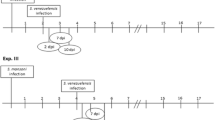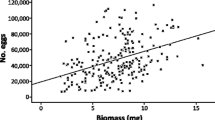Abstract
This study compared the course of Ancylostoma ceylanicum infection in hamsters infected with different inocula and the consequences for the host and helminth populations. The average of adult worms recovered, according to the number of third stage larva used, were 28.0, 24.8, 24.6, and 24.8 % to inocula size of 25 L3, 75 L3, 125 L3, and 250 L3, respectively. The size of the inoculum did not affect the establishment, survival, or fecundity of adult helminths. Reductions in the red blood cell and hemoglobin levels in the infected group were inversely proportional to the number of white blood cells. Moreover, differential cell counting revealed a positive correlation between the worm load and leucocyte numbers. The humoral response against excretion-secretion antigens was more robust and sensitive compared with the response against crude extract, with no direct linear correlation with the number of worms. The effect of the population density was more evident in females.







Similar content being viewed by others
References
Alkazmi LM, Behnke JM (2013) The mucosal response of hamsters exposed to weekly repeated infections with the hookworm Ancylostoma ceylanicum. J Helminthol 87:309–317
Alkazmi LM, Dehlawi MS, Behnke JM (2006) The effect of the hookworm Ancylostoma ceylanicum on the mucosal architecture of the small intestine in hamsters. J Helminthol 80:397–407
Alkazmi LM, Dehlawi MS, Behnke JM (2008) The mucosal cellular response to infection with Ancylostoma ceylanicum. J Helminthol 82:33–44
Andreassen J, Bennet-Jenkins EM, Bryant C (1999) Immunology and biochemistry of Hymenolepis diminuta. Adv Parasitol 42:223–275
Behnke O (1987) Do hookworms elicit protective immunity in man? Parasitol Today 3:200–206
Blackweel AD, Martin M, Kaplan H, Gurven M (2013) Antagonism between two intestinal parasites in humans: the importance of co-infection for infection risk and recovery dynamics. Proc Biol Sci 280(1769):20131671
Bundy DA, Chan MS, Savioli L (1995) Hookworm infection in pregnancy. Trans R Sco Trop Med Hyg 89:521–522
Bungiro RD Jr, Greene J, Kruglov E, Cappello M (2001) Mitigation of hookworm disease by immunization with soluble extracts of Ancylostoma ceylanicum. J Infect Dis 183:1380–1387
Bungiro RD Jr, Sun T, Harrison LM, Shoemaker CB, Cappello M (2008) Mucosal antibody responses in experimental hookworm infection. Parasite Immunol 30:293–303
Bush AO, Lotz JM (2000) The ecology of “crowding”. J Parasitol 86:212–213
Cox FEG (2001) Concomitant infections, parasites and immune responses. Parasitology 122:S23–S38
Davey D, Manickam N, Simms BT, Harrison LM, Vermeire JJ, Cappello M (2013) Frequency and intensity of exposure mediate resistance to experimental infection with the hookworm Ancylostoma ceylanicum. Exp Parasitol 133:243–249
De Silva NR, Brooker S, Hotez PJ, Montresor A, Engels D, Savioli L (2003) Soil-transmitted helminth infections: updating the global picture. Trends Parasitol 19:547–551
Dias SRC, Costa AFDV, Gazzinelli-Guimarães PH, Roatt BM, Fonseca KS, Paiva NCN, Giunchetti RC, Carneiro CM, Fujiwara RT, Rabelo EML (2013) Prednisolone and cyclosporine a: effects on an experimental model of ancylostomiasis. Exp Parasitol 133:80–83
Dondji B, Bungiro RD, Harrison LM, Vermeire JJ, Bifulco C, McMahon-Pratt D, Cappello M (2008) Role for nitric oxide in hookworm-associated immune suppression. Infect Immun 76:2560–2567
Fenton A, Knowles SCL, Pechey OL, Pedersen AB (2014) The reliability of observational approaches for detectin interspecific parasite interactions: comparison with experimental results. Int J Parasitol 44:437–445. doi:10.1016/j.ijpara.2014.03.001
Garside P, Behnke JM (1989) Ancylostoma ceylanicum in the hamster: observations on the host-parasite relationship during primary infection. Parasitology 98:283–289
Ghosh K, Wu W, Antoine AD, Bottazzi ME, Valenzuela JG, Hotez PJ, Mendez S (2006) The impact of concurrent and treated Ancylostoma ceylanicum hookworm infections on the immunogenicity of a recombinant hookworm vaccine in hamsters. J Infect Dis 193:155–162
Goater CP (1992) Experimental population dynamics of Rhabdias bufonis (Nematoda) in toads (Bufo bufo): density-dependence in the primary infection. Parasitology 104(Pt 1):179–187
Gordon HM, Whitlock HV (1939) A new technique for counting nematode eggs in sheep faeces. J Counc Sci Ind Res 12:50–52
Gulland FM (1992) The role of nematode parasites in Soay sheep (Ovis aries L.) mortality during a population crash. Parasitology 105:493–503
Holmes JC (1961) Effects of concurrent infections on Hymenolepis diminuta (Cestoda) and Moniliformis dubius (Acanthocephala). I. General effects and comparison with crowding. J Parasitol 47:209–216
Hooper LV, Gordon JI (2001) Commensal host-bacterial relationships in the gut. Science 292:1115–1118
Hooper LV, Littman DR, Macpherson AJ (2012) Interactions between the microbiota and the immune system. Science 336:1268–1273
Hotez PJ, Pritchard DI (1995) Hookworm infection. Sci Am 272:68–74
Hotez PJ, Bethony J, Bottazzi ME, Brooker S, Diemert D, Loukas A (2006) New technologies for the control of human hookworm infection. Trends Parasitol 22:327–331
Humason GL (1972) Animal tissue techniques. W.H. Freeman, San Francisco, p 641p
Loukas A, Prociv P (2001) Immune responses in hookworm infections. Clin Microbiol Rev 14:689–703
Marcogliese DJ (1997) Fecundity of sealworm (Pseudoterranova decipiens) infecting grey seals (Halichoerus grypus) in the Gulf of St. Lawrence, Canada: lack of density-dependent effects. Int J Parasitol 27:1401–1409
Michael E, Bundy DA (1989) Density dependence in establishment, growth and worm fecundity in intestinal helminthiasis: the population biology of Trichuris muris (Nematoda) infection in CBA/Ca mice. Parasitology 98:451–458
Mitruka BM, Rawnsley HM (1981) Clinical biochemical and hematological reference values in normal experimental animals and humans. Masson Publishing, New York
Pansky B, Jacobs M, House EL, Tassoni JP (1961) The orbital region as a source of blood samples in the golden hamster. Anat Rec 139:409–412
Paterson S, Viney ME (2002) Host immune responses are necessary for density dependence in nematode infections. Parasitology 125:283–292
Petney TN, Andrews RH (1998) Multiparasite communities in animals and humans: frequency, structure and pathogenic significance. Int J Parasitol 28:377–393
Pritchard DI, Brown A (2001) Is Necator americanus approaching a mutualistic symbiotic relationship with humans? Trends Parasitol 17:169–172
Prociv P, Croese J (1990) Human eosinophilic enteritis causes by dog hookworm Ancylostoma caninum. Lancet 335:1299–1302
Read CP (1951) The “crowding effect” in tapeworm infections. J Parasitol 37:174–178
Roberts LS (2000) The crowding effect revisited. J Parasitol 86:209–211
Roberts LS, Insler GD (1982) Developmental physiology of cestodes. XVII. Some biological properties of putative “crowding factors” in Hymenolepis diminuta. J Parasitol 68:263–269
Roche M, Layrisse M (1966) The nature and causes of “hookworm anemia”. Am J Trop Med Hyg 15:1029–1102
Roche M, Patrzed D (1966) The female to male ratio (FMR) in hookworm. J Parasitol 52:117–121
Romeo C, Wauters LA, Cauchie S, Martinoli A, Matthysen E, Saino N, Ferrari N (2014) Faecal egg counts from field experimental reveal density dependence in helminth fecundity: Strongyloides robustus infecting grey squirrels (Sciurus carolinensis). Parasitol Res 113:3403–3408
Sowemimo OA, Asaolu SO (2008) Epidemiology of intestinal helminth parasites of dogs in Ibadan, Nigeria. J Helminthol 82:89–93
Stear MJ, Bishop SC, Doligalska M, Duncan JL, Holmes PH, Irvine J, McCririe L, McKellar QA, Sinski E, Murray M (1995) Regulation of egg production, worm burden, worm length and worm fecundity by host responses in sheep infected with Ostertagia circumcincta. Parasite Immunol 17:643–652
Stear MJ, Park M, Bishop SC (1996) The key components of resistance to Ostertagia cincumcinta in lambs. Parasitol Today 12(11):438–441
Stoltzfus RJ, Albonico M, Chwaya HM, Savioli L, Tielsch J, Schulze K, Yip R (1996) Hemoquant determination of hookworm-related blood loss and its role in iron deficiency in African children. Am J Trop Med Hyg 55:399–404
Sykes AR (1987) Endoparasites and herbivore nutrition. In: Hacker JB, Thernouth JH (eds) Nutrition of herbivores. Academic, Australia, pp 211–233
Tompkins DM, Hudson PJ (1999) Regulation of nematode fecundity in the ring-necked pheasant (Phasianus colchicus): not just density dependence. Parasitology 118:417–423
WHO (2012) Hookworm disease: disease burden. In: Research, I.f.V., (Ed.), Parasitic Diseases, pp. prevalence stats for hookworm worldwide
Yazima F, Machida K (1958) On the ecological relations of parasite state of Ancylostoma caninum, especially on the density effect of population. Jpn J Parasitol 7:631–640
Acknowledgments
This work was supported by CAPES, FAPEMIG, and Pró-Reitoria de Pesquisa da UFMG.
Author information
Authors and Affiliations
Corresponding author
Rights and permissions
About this article
Cite this article
Serafim, L.R., da Silva, J.P.G., de Paiva, N.C.N. et al. The crowding effect in Ancylostoma ceylanicum: density-dependent effects on an experimental model of infection. Parasitol Res 113, 4611–4621 (2014). https://doi.org/10.1007/s00436-014-4151-y
Received:
Accepted:
Published:
Issue Date:
DOI: https://doi.org/10.1007/s00436-014-4151-y




